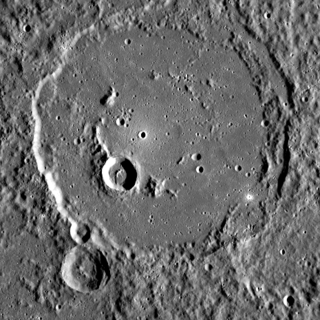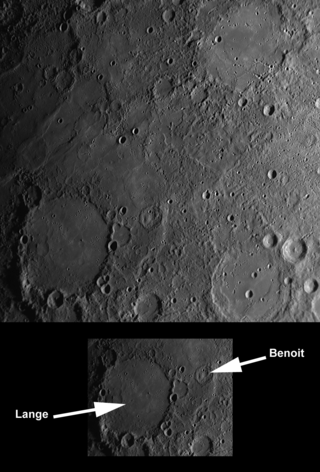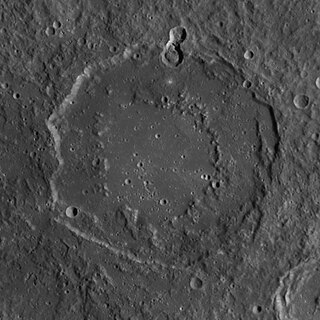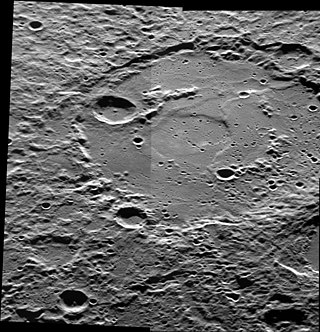
Matisse is an impact crater on the southern hemisphere of Mercury. Matisse takes its name from the French artist Henri Matisse, and it was named by the IAU in 1976.

Mozart is a crater on Mercury, named by the IAU in 1976 after Austrian composer Wolfgang Amadeus Mozart.

Raphael is a crater on Mercury. Its name was adopted by the International Astronomical Union (IAU) in 1976, and is named for the Italian painter Raphael.

Polygnotus is a crater on Mercury, named by the IAU in 1976, after ancient Greek painter Polygnotus.

Praxiteles is a crater on Mercury. It is one of 110 peak ring basins on Mercury.

Moody is an impact crater on Mercury.

Munkácsy, named after Mihály Munkácsy, is a crater on Mercury. Munkácsy originally had a double-ring basin structure, but most of the inner ring was buried when the basin was flooded with volcanic lava. Only a few remnants of the ring poke up through the lava, although low ridges in the lava seem to trace out much of the rest of the ring's circumference. Munkácsy is one of 110 peak ring basins on Mercury.

Izquierdo is a crater on Mercury. Its name was adopted by the International Astronomical Union (IAU) in 2009, for the Mexican painter María Izquierdo. The floor of Izquierdo is smooth, the result of having been partially filled with volcanic lava. Circular outlines of the rims of “ghost craters” – smaller, older craters that have been largely buried by the lavas that infilled the basin – are visible in a few places on Izquierdo's floor. The remnants of a buried inner ring are also barely discernible in spots, and it is one of 110 peak ring basins on Mercury. There have been more recent impacts into the floor of Izquierdo, resulting in some small, sharply defined craters.

Lange is a crater on Mercury. It was named by the IAU in 2009 after American photographer Dorothea Lange.

Ahmad Baba is a crater on Mercury. It has a diameter of 127 kilometers. Its name was adopted by the International Astronomical Union (IAU) in 1979.

Mark Twain is a crater on Mercury. Its name was adopted by the International Astronomical Union (IAU) in 1976. Mark Twain is named for the American author Mark Twain, who lived from 1835 to 1910.

Pahinui is a crater on Mercury. Its name was adopted by the International Astronomical Union in 2016, after the Hawaiian musician, Charles Phillip Kahahawai "Gabby" Pahinui.

Nabokov is a crater on Mercury. Its name was adopted by the International Astronomical Union (IAU) on April 24, 2012. Nabokov is named for the Russian and American author Vladimir Nabokov.

Rustaveli is a crater on Mercury. Its name was adopted by the International Astronomical Union in 2012, after the Georgian poet Shota Rustaveli.

Seuss is a crater on Mercury. Its name was adopted by the International Astronomical Union (IAU) in 2012. It is named for the American author and cartoonist Theodor Seuss Geisel, better known as Dr. Seuss.

Donelaitis is a crater on Mercury. Its name was adopted by the International Astronomical Union (IAU) on May 15, 2013. Donelaitis is named for the Lithuanian poet Kristijonas Donelaitis.

Jobim is a crater on Mercury. It has a diameter of 167 kilometres. Its name was adopted by the International Astronomical Union (IAU) on September 25, 2015. Jobim is named for the Brazilian composer Antônio Carlos Jobim.

Steichen is a crater on Mercury. Its name was adopted by the International Astronomical Union (IAU) in 2010. The crater was named after American photographer and painter, Edward Steichen.

Coatl Facula is a bright region about 49 km wide on the surface of Mercury, located at 29.75° S, 216.55° W. It was named by the IAU in June 2020. Coatl is the Aztec (Nahuatl) word for snake.




















